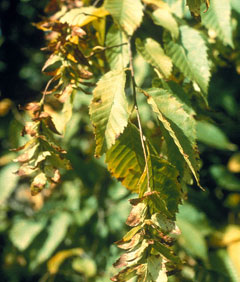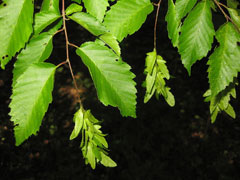 |
|
http://commons.wikimedia.org/wiki/User:MPF |
 |
|
Translate this page:
Summary
Bloom Color: Orange, Yellow.
Main Bloom Time: Early spring, Late spring, Mid spring.Form: Oval.
Physical Characteristics

 Carpinus caroliniana is a deciduous Tree growing to 12 m (39ft) by 10 m (32ft) at a slow rate.
Carpinus caroliniana is a deciduous Tree growing to 12 m (39ft) by 10 m (32ft) at a slow rate.
See above for USDA hardiness. It is hardy to UK zone 5. It is in flower from April to May, and the seeds ripen in November. The species is monoecious (individual flowers are either male or female, but both sexes can be found on the same plant) and is pollinated by Wind.
Suitable for: light (sandy), medium (loamy) and heavy (clay) soils and can grow in heavy clay soil. Suitable pH: mildly acid, neutral and basic (mildly alkaline) soils and can grow in very alkaline soils.
It can grow in semi-shade (light woodland) or no shade. It prefers moist soil.
UK Hardiness Map
US Hardiness Map
Synonyms
C. americana.
Plant Habitats
Woodland Garden Canopy; Secondary;
Edible Uses
Edible Parts: Seed
Edible Uses:
Seed - cooked[105]. An emergency food, used when all else fails[177].
References More on Edible Uses
Medicinal Uses
Plants For A Future can not take any responsibility for any adverse effects from the use of plants. Always seek advice from a professional before using a plant medicinally.
Astringent
American hornbeam was employed medicinally by some native North American Indian tribes, though it is not used in modern herbalism[257]. The inner bark is astringent[257]. An infusion has been used in the treatment of diarrhoea and difficult urination with discharge[257].
References More on Medicinal Uses
The Bookshop: Edible Plant Books
Our Latest books on Perennial Plants For Food Forests and Permaculture Gardens in paperback or digital formats.

Edible Tropical Plants
Food Forest Plants for Hotter Conditions: 250+ Plants For Tropical Food Forests & Permaculture Gardens.
More

Edible Temperate Plants
Plants for Your Food Forest: 500 Plants for Temperate Food Forests & Permaculture Gardens.
More

More Books
PFAF have eight books available in paperback and digital formats. Browse the shop for more information.
Shop Now
Other Uses
Wood
Wood - heavy, close grained, very hard, strong, but not very durable in the soil. It weighs 45lb per cubic foot. Too small to be exploited commercially, this high quality wood is often used locally for flooring, cogs, tool handles, golf clubs etc[46, 61, 82, 171, 226, 227, 229, 235]. It is especially suitable for making levers[171] and is also a good fuel[61].
Special Uses
Espalier
References More on Other Uses
Cultivation details
Landscape Uses:Espalier, Pest tolerant, Hedge, Standard, Superior hedge, Specimen, Street tree, Woodland garden. Thrives in any good loam, including chalk, it does not demand much light[1, 11]. Prefers a deep open loam[1]. Grows well in heavy clay soils. A slow-growing and short-lived tree in the wild[229], it is slower growing than C. betulinus in cultivation[11]. Seed production is cyclic, a year of heavy yields being followed by 2 - 4 years of low yields[229]. Special Features:
North American native, Attracts butterflies, Inconspicuous flowers or blooms.
References Carbon Farming Information and Carbon Sequestration Information
Temperature Converter
Type a value in the Celsius field to convert the value to Fahrenheit:
Fahrenheit:
The PFAF Bookshop
Plants For A Future have a number of books available in paperback and digital form. Book titles include Edible Plants, Edible Perennials, Edible Trees,Edible Shrubs, Woodland Gardening, and Temperate Food Forest Plants. Our new book is Food Forest Plants For Hotter Conditions (Tropical and Sub-Tropical).
Shop Now
Plant Propagation
Seed - best sown in an outdoors seedbed as soon as it is ripe[78]. Germination is usually good, though it may take 18 months[80]. If collected whilst still 'green' (after the seed is ripe but before it has dried fully on the plant) and sown immediately it should germinate in the following spring[80]. Grow the plants on for two years in the seedbed and then plant them out into their permanent positions in the winter. The average seed viability is around 65%[98]. Pre-treat stored seed with 4 weeks warm and 12 weeks cold stratification and sow in a cold frame[98]. When they are large enough to handle, prick the seedlings out into individual pots and grow them on in a cold frame until they are at least 15cm tall before planting them into their permanent positions.
Other Names
If available other names are mentioned here
Native Range
NORTHERN AMERICA: Canada (Ontario, Québec), United States (Connecticut, Indiana, Maine, Massachusetts, Michigan, New Hampshire, New Jersey, New York, Ohio, Pennsylvania, Rhode Island, Vermont, West Virginia, Illinois, Iowa, Minnesota, Missouri, Oklahoma, Wisconsin, Alabama, Arkansas, Florida, Georgia, Kentucky, Louisiana, Maryland, Mississippi, North Carolina, South Carolina, Tennessee, Virginia, Texas)
Weed Potential
Right plant wrong place. We are currently updating this section.
Please note that a plant may be invasive in one area but may not in your area so it's worth checking.
Conservation Status
IUCN Red List of Threatened Plants Status :

Growth: S = slow M = medium F = fast. Soil: L = light (sandy) M = medium H = heavy (clay). pH: A = acid N = neutral B = basic (alkaline). Shade: F = full shade S = semi-shade N = no shade. Moisture: D = dry M = Moist We = wet Wa = water.
Now available:
Food Forest Plants for Mediterranean Conditions
350+ Perennial Plants For Mediterranean and Drier Food Forests and Permaculture Gardens.
[Paperback and eBook]
This is the third in Plants For A Future's series of plant guides for food forests tailored to
specific climate zones. Following volumes on temperate and tropical ecosystems, this book focuses
on species suited to Mediterranean conditions—regions with hot, dry summers and cool, wet winters,
often facing the added challenge of climate change.
Read More
Expert comment
Author
Walter.
Botanical References
1143200
Links / References
For a list of references used on this page please go here
Readers comment
| Add a comment |
|
If you have important information about this plant that may help other users please add a comment or link below. Only comments or links that are felt to be directly relevant to a plant will be included. If you think a comment/link or information contained on this page is inaccurate or misleading we would welcome your feedback at [email protected]. If you have questions about a plant please use the Forum on this website as we do not have the resources to answer questions ourselves.
* Please note: the comments by website users are not necessarily those held by PFAF and may give misleading or inaccurate information.
To leave a comment please Register or login here All comments need to be approved so will not appear immediately.
|
Subject : Carpinus caroliniana
|
|
|
|